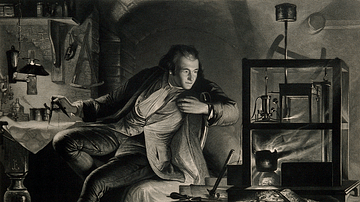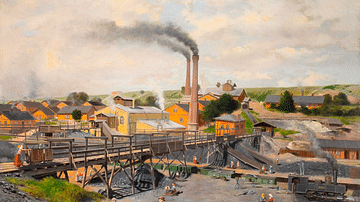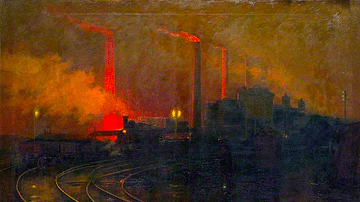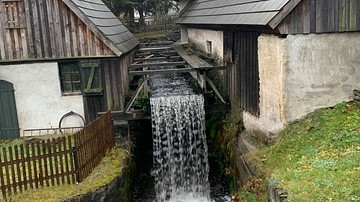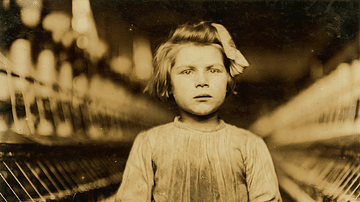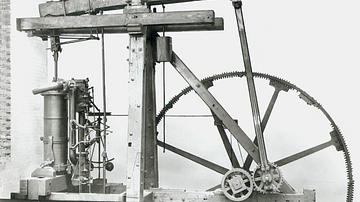Coal mining boomed during the British Industrial Revolution as it provided fuel for steam engines of all kinds in factories, transport, and agriculture. Draining flooded mines to extract more coal was the reason the steam engine was invented. As lighting used coal gas, and coke was needed to make iron and steel, so the demand for coal kept on growing.
An Abundant Natural Resource
Coal mining had been a major industry in Britain from the 16th century, ever since forests had been depleted and wood for fuel became scarce. There were four main coalfields: South Wales, southern Scotland, Lancashire, and Northumberland. All four produced high-quality coal, and all were conveniently positioned near waterways of one sort or another which could transport the coal to other regions. The abundance of coal and the early exploitation of it (half a century or more ahead of other European nations) meant that Britain already had the mining resources and know-how to fully exploit the arrival of industrial machines and other inventions which needed coal or its byproducts as a fuel. These coal-hungry inventions of the Industrial Revolution created a massive and sustained boom in coal mining.
The Steam Engine
The greatest invention of the Industrial Revolution was the steam engine, which transformed all manner of tasks and transportation from relying on human, animal, wind, or water power to using the far greater, cheaper, and more consistent power of machines. The steam engine was invented in the first place so that coal mines could be mined deeper and floodwaters pumped out of the shafts. By 1700, Britain already produced 80% of the coal in Europe. It was in 1712 that the first steam engine pump was built by Thomas Newcomen (1664-1729) to drain coal mines of water in Dudley in the Midlands. The steam engine needed coal for its fuel, and so when the invention was made more efficient and adapted for other uses by such inventors as James Watt (1736-1819) and Matthew Boulton (1728-1809), so the demand for coal grew. Steam engines were used to power cotton looms, steam hammers, threshing machines, and any other kind of heavy machinery that saved the costs of human and animal labour.
Coal & Transportation
The boom in coal production caused a massive expansion in the canal system along and connecting all major rivers and their tributaries from 1750 as this was still the cheapest way to transport such heavy goods (at around half the cost of using roads). By 1830, "England and Wales had 3,876 miles [6,237 km] of inland canals, up from 1,399 [2,251 km] in 1760" (Horn, 17).
From 1825, the railways and their steam trains needed coal. The idea of railways had been born from the short stretches of rails used for pulling along carts of coal from the mine entrance to where it could be transported elsewhere by barge or ship. George Stephenson (1781-1848) owned a company in Newcastle that specialised in building railway trains to transport coal over short distances at coal mines. Stephenson designed the Locomotion 1 train engine. This locomotive was powerful enough to pull carriages, and it transported the first steam railway passengers from Stockton to Darlington in the northeast of England in 1825. From there, the railway network grew to connect practically all of Britain's cities and major towns.
From the mid-19th century, great new steamships like SS Great Britain (1843) and SS Great Eastern (1858) devoured hundreds of tons of coal each voyage as they crossed the Atlantic and other oceans. Even more traditional transport like canal boats were fitted with coal-eating engines.
Coal Gas Lighting
Around 1792-4 the Scotsman William Murdock (1754-1839) first demonstrated coal gas could be used for lighting. Murdock had been alerted to the possibility when he had filled a smoking pipe with coal dust and the escaping gas lit when he placed it near an open fire. This new and brighter source of illumination replaced the burning of oil or tallow candles. The idea to use coal gas for street lighting was pioneered by the German inventor Frederick Albert Winsor (1763-1830) from 1807. Winsor spectacularly demonstrated the potential of his idea by setting up gas streetlights from Pall Mall to St James' Park in London, knowing that King George III of Great Britain (r. 1760-1820) would pass that way in his carriage. The demonstration caused a sensation, and Pall Mall received 13 permanent gas-lit lampposts and so became the first street in the world to be so illuminated.
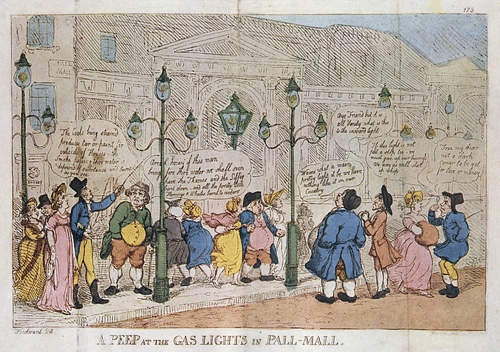
Much wrangling with Parliament meant it was not until 1812 that Winsor won a contract to light more of London with his invention. Over the next decade, the capital was given 40,000 gas streetlights. The addition of light to previously dark streets transformed people's habits and, seen as much safer to go out at night, restaurants and entertainment establishments were able to attract far more customers than previously. The idea was a winner, and it soon spread to other British cities and abroad. In 1816, Baltimore became the first city in the United States to use coal gas street lighting; Paris followed suit in 1820.
Coal gas was also used for cookers in people's homes. By the 1850s, every major town had a gasworks. Coal and gas for heating meant that wood was no longer needed in such quantities, allowing land which had previously been reserved for forests to be used instead for agriculture.
Other Uses of Coal
Coke, made from burning coal in a furnace to remove as many impurities as possible, became an essential fuel for iron- and steelworks. The first working blast furnace using coke was used in 1709 at Coalbrookdale in Shropshire, a works owned by Abraham Darby (1678-1717). Coke-fuelled blast furnaces could reach much higher temperatures than the traditional fuel of charcoal and did not introduce impurities into the furnace, two essentials for making the best steel. Coal, meanwhile, was used as a source of heat in anything from brickworks to breweries. The high concentration of factories in the West Midlands and their heavy use of coal meant the region became known as the 'Black Country'. Byproducts of making coke besides coal gas included tar and numerous chemicals. In the last quarter of the 19th century, coal was used, and still is, to generate electricity.
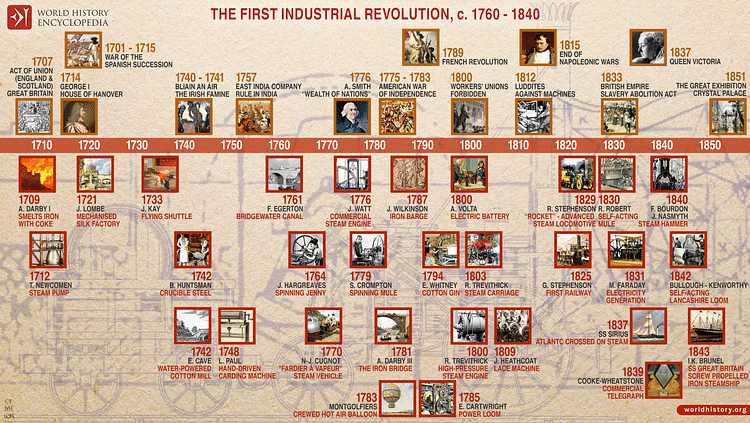
Britain produced annually just 2.5 to 3 million tons of coal in 1700, but by 1900, this figure had rocketed to 224 million tons. In the 19th century, Britain was mining two-thirds of the world's coal. One French manufacturing inspector on a tour of Britain, Monsieur Ticquet, noted in 1738 that "Coal is one of the great sources of richness and abundance in England, and I regard it as the soul of the English manufactures" (Horn, 40). By the time of the 1851 census, there were 220,000 coal miners in Britain.
Coal had become the lifeblood of the Industrial Age, its value demonstrable in statistics and charts but also more romantically in, for example, the decision of the exhibitors in the Great Exhibition of 1851 in London's Crystal Palace to include in their exhibits of the wonders of the modern era a 24-ton chunk of coal. Rather less wonderous was the great air pollution that the burning of coal created in cities and areas of heavy industry.
Working Conditions in Mines
Working in a mine is never the pleasantest of environments, but in the 18th and 19th centuries, the conditions were particularly poor. Hard physical work, most coal faces were worked using pickaxes. The seam of coal being worked might be very narrow indeed so that a miner was forced to work in a space no higher than 30 inches (75 cm). Women and children were employed in the mines. Women were used to carry heavy baskets of coal from the face to carts for transportation, which usually involved walking through water.
Children as young as five years old were found useful to climb into narrow ventilation shafts and ensure trapdoors were regularly opened and shut. Most children, though, were employed to either shift the coal from the working level to the surface or to sort it out from other debris before it was shipped away. Those who pulled the coal in carts using a harness were known as 'hurriers', and it was back-breaking work detrimental to the child's physical development. Many parents were not opposed to their children working, despite the health hazards, since they brought in much-needed earnings for the family. In addition, over half of children working in mines kept their employment when they reached adulthood. From 1800 to 1850, children composed between 20-50% of the mining workforce. The consequence of working at such an early age was that most children employed in mines never had more than three years of schooling.
Men, women, and children very often suffered health problems from the physical hard work and long, 12-hour shifts. Breathing in coal dust year after year caused many to develop lung diseases. As the historian S. Yorke emphatically notes, "The coal mining industry must represent one of the worst exploitations of men, women and children ever to have taken place in Britain" (98).
The Safety Lamp
With more miners working ever deeper within the Earth, more accidents inevitably occurred. In 1838, there were 97 deaths from roof collapses; in 1864, there were 395. Ropes breaking and letting fall great weights was another common occurrence but was reduced after the introduction of steel cables in mines from the early 1800s.
Another serious threat to life and limb was the explosion of gases (called by miners fire-damp or mine-damp, a lethal mix of methane gas and coal dust) which built up during the mining process. The naked flame of the lamps used to illuminate the shafts igniting the gas was the cause of such explosions.
In 1815, Humphrey Davy (1778-1820) and George Stephenson (1781-1848) independently invented the safety lamp for use by miners, which enclosed the flame in a fine mesh (allowing air in but not the flame to spread out). In addition, if the flame of the lamp turned from orange to blue it indicated that the gas levels were dangerously high in the shaft and it was time to leave. Thirdly, the lamp could detect a dangerous amount of carbon dioxide (choke-damp) in the air as the flame extinguished itself allowing miners to leave the area before that gas built up to a fatal quantity. Davy's lamp, the most effective of the two, was first used in a coal mine in County Durham in 1816. The lamp saved countless lives, but it is also true that miners grew to depend on the lamps so much that they often took risks in exploring potentially dangerous passages in a mine that otherwise would have been left alone. The safety lamp was not as bright as candlelight either, and so many miners refused to use the new invention even if candles were prohibited.
Reform: The 1842 Mines Act
In 1842, the Mines Act was pushed through via the efforts of Lord Ashley, Earl of Shaftesbury (1801-1885), and public outrage at the increasing frequency of accidents and the knowledge that men and women were working together underground in a state of undress in the hot conditions. Ashley headed a Royal Commission that investigated working conditions in several mines and compiled testimony from those who worked in them. There were opponents to the Act, primarily mine owners and those who were against government interference in industry in principle. This opposition was the major reason why a recommendation to reduce working days from 12 hours to 10 never became a reality. Nevertheless, the Act now prohibited the employment of women, girls, and boys under 10 years of age from working underground. Safety regulations were to be better enforced, and only those over 15 years of age could operate machinery. Mine inspectors were employed by the government to ensure the new rules were put into practice. In the short term, the Act did mean that many women lost their jobs, and families with only daughters suffered severe financial hardship.
For good or bad, coal mining was a mainstay of the British economy into the 20th century. The noted historian Alan Macfarlane summarises the importance of coal to the Industrial Revolution and life as we know it today:
Our civilization in the modern world is built first on coal and later of course on other carbon energy – oil, and so on. Without this, there could have been no Industrial Revolution, it couldn't have happened in England and we would still be living in an agrarian society.
(Dugan, 67)




